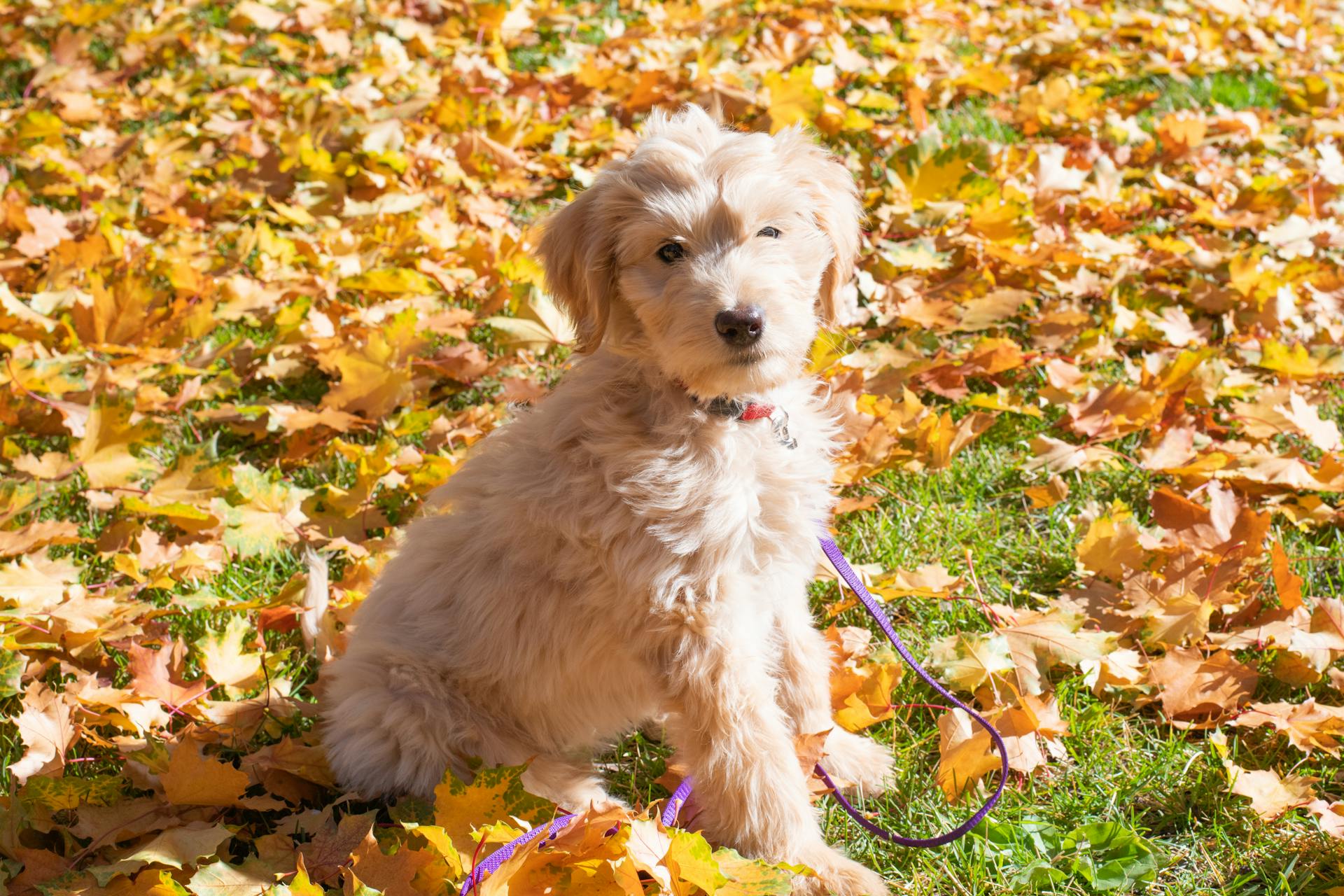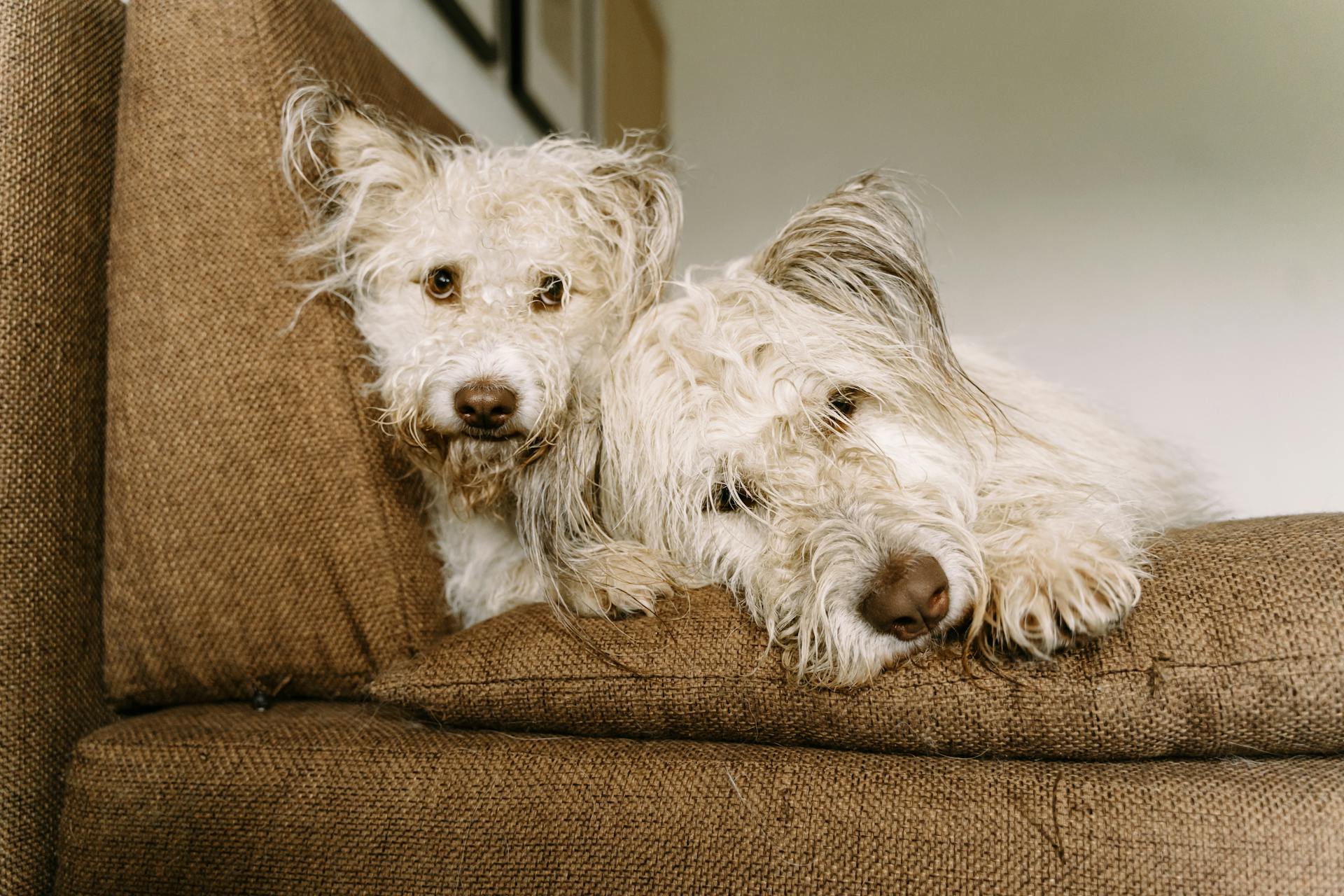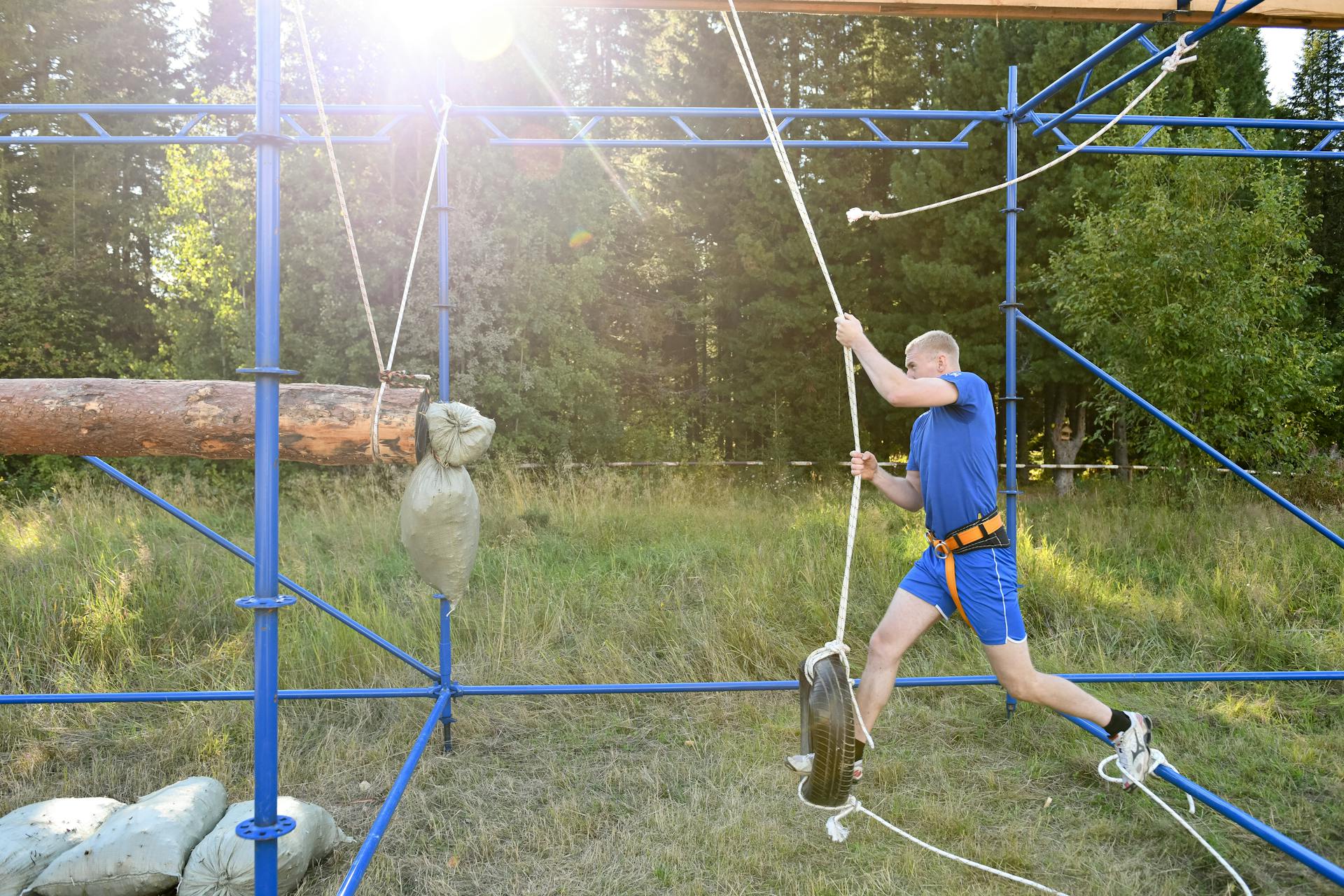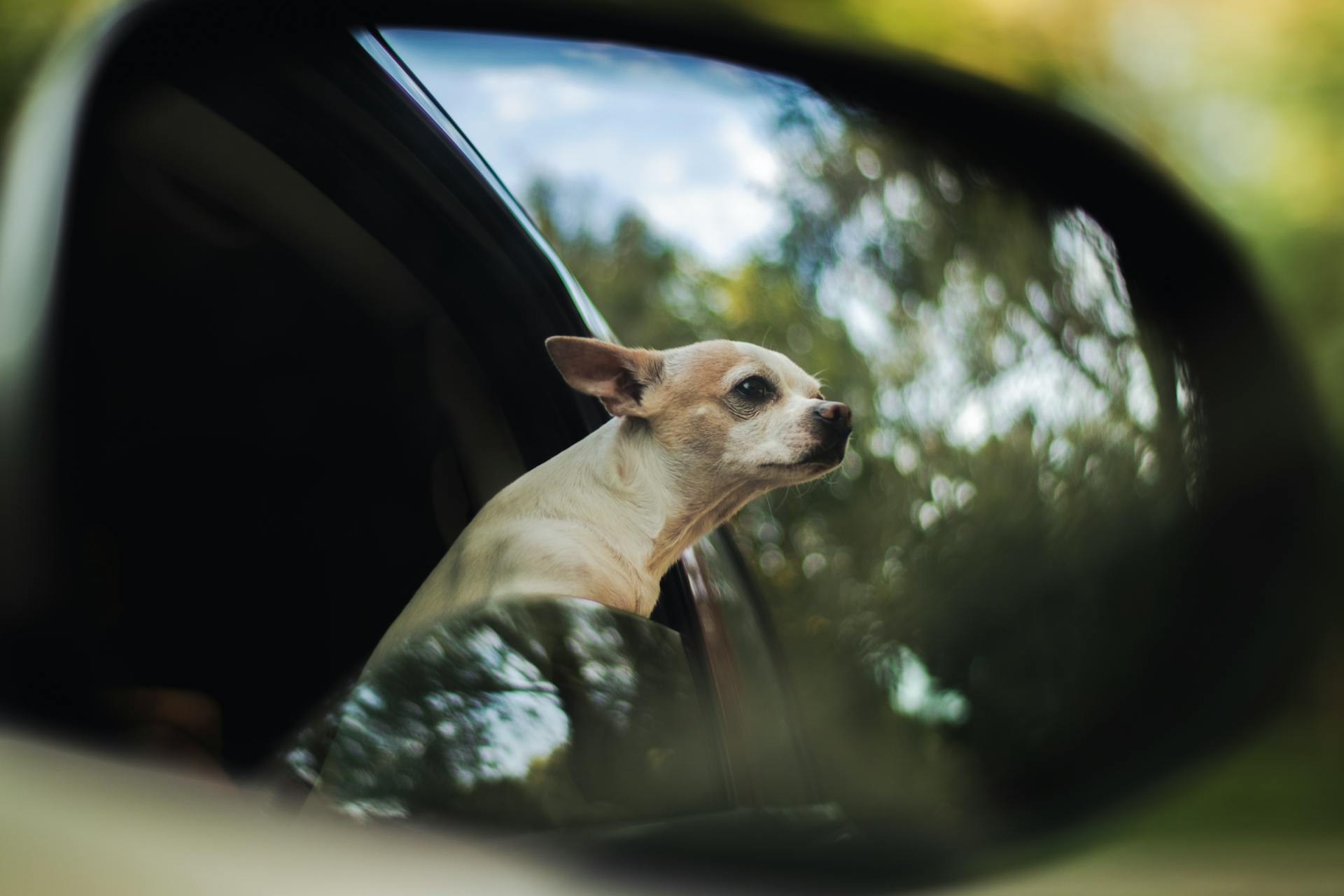
Goldendoodles are known to be intelligent and social dogs, but like any breed, they can be prone to separation anxiety. This can manifest in destructive behavior, such as chewing or digging, when left alone.
Separation anxiety in Goldendoodles is often linked to their strong attachment to their owners. According to studies, Goldendoodles tend to form close bonds with their family members, which can make it difficult for them to adjust to being alone.
To manage separation anxiety in Goldendoodles, it's essential to establish a gradual separation routine. This can be achieved by starting with short periods of separation and gradually increasing the duration over time.
With patience and consistency, you can help your Goldendoodle feel more secure when you're away.
Understanding Goldendoodle Temperament
Goldendoodles are a social breed that thrives on attention and affection, making them great companions for families and individuals alike.
Their friendly and sociable nature is one of the reasons they're so popular as pets. They love to be around people and enjoy spending time with their family members.
One of the most common traits of Goldendoodles is their affectionate nature. They love to cuddle and be close to their family members, making them a great choice for people who want a pet that will provide love and comfort.
Goldendoodles are also known for their loyalty. They're fiercely protective of their family and will do anything to keep them safe. This makes them a great choice for families looking for a pet that will be devoted to them.
Their playful nature is another reason they're so lovable. They're active and enjoy playing games and going for walks, making them a great playmate for children.
Here are some common signs of separation anxiety in Goldendoodles:
- panting
- yawning
- drooling
- pacing
- whining
By recognizing these signs, you can take steps to prevent separation anxiety in your Goldendoodle. Providing comforting toys or challenging puzzles when they're left alone can help prevent boredom and anxiety.
Goldendoodles often have a special connection with one person in particular, which can lead to separation anxiety when they're apart from that person for extended periods.
Causes and Symptoms of Separation Anxiety
Separation anxiety is a common issue that affects many dogs, including Goldendoodles. It's estimated that 1 in 7 dogs experience separation anxiety, which is around 13 million dogs in the United States alone.
Some dogs may become anxious when alone, while others only exhibit anxiety when separated from a particular person. In many cases, a dog will start to show anxious behaviors when they think they are about to be left alone due to the anticipation of being alone or away from their person.
The most common symptoms of separation anxiety include vocalization, destructive chewing or scratching, and potty accidents. More subtle signs may include pacing, drooling, panting, and watchful waiting.
Dogs may also exhibit self-harm or acral lick, excessive greetings, and clingy behavior. These behaviors can be triggered by various factors, including previous bad experiences, being re-homed or growing up in a shelter environment, and lack of socialization during their critical development period as a puppy.
Expand your knowledge: Dog Anxiety Boarding
Here are some common causes of separation anxiety in dogs:
- Previous bad experience(s) when left alone
- Being re-homed or growing up in a shelter environment
- Lack of socialization during their critical development period as a puppy
- Possible genetic component
- Never taught how to cope with being alone
- Canine cognitive dysfunction ("doggy dementia")
- Change in routine (e.g. loss or addition of a family member)
- Suffering from other anxieties (noise phobia, travel anxiety, etc.)
It's essential to recognize the signs of separation anxiety in your Goldendoodle and address the issue promptly to prevent it from worsening. With patience, consistency, and positive reinforcement training, you can help your dog feel more comfortable and secure when left alone.
Preventing and Managing Separation Anxiety
Preventing and managing separation anxiety in goldendoodles requires a thoughtful approach. It's essential to never leave your dog alone for longer than they can handle. This may mean changing your schedule or asking friends and family to watch your dog while you're away.
A daily routine is crucial in preventing separation anxiety in goldendoodles. Introducing a routine can help your dog feel secure and reduce anxiety. According to Preventive Vet, a daily routine is important not only for puppies but also to prevent issues such as separation anxiety.
To prevent separation anxiety, it's also essential to provide your dog with adequate exercise and mental stimulation. Exercise can help reduce anxiety in dogs, and it's recommended to exhaust your dog before leaving them alone. Leaving a special toy or bone in their crate can also help your dog build a positive connection with alone time.
For more insights, see: Daily Dog Training
Preventing Before It Starts
Preventing separation anxiety before it starts is possible, but it's not a guarantee. Many variables can contribute to a dog developing separation anxiety, and some may be out of your control.
Practicing preventive exercises can help, but even with these efforts, a dog may still develop separation anxiety in the future. It's essential to remember that it's not your fault.
Crate training can help prevent separation anxiety if done correctly. Proper crate training teaches your dog to relax when confined and away from you, creating a positive association with being in the crate.
However, crate training should be done responsibly and not for extended periods. For dogs who struggle with being confined or have never been crate trained, it's not recommended to use a crate to help with separation anxiety.
Systematic desensitization is a process that can help prevent separation anxiety by slowly exposing your dog to the things that typically cause their anxiety. This process involves changing their negative association with your departure and absence to a neutral one.
You might like: Will Spaying My Dog Help with Aggression
Introducing alone time in easy-to-handle "bite-sized" steps is also an effective way to prevent separation anxiety. This can be done by starting with short periods of time and gradually increasing the duration.
It's crucial to create a daily routine for your dog, which can help prevent separation anxiety. A daily routine provides structure and consistency, making it easier for your dog to cope with being alone.
Exercise is also essential in preventing separation anxiety. Tiring your dog out with physical exercise can help them sleep better and reduce anxiety.
Spending too much time with your puppy can actually contribute to separation anxiety. It's essential to give your puppy time to learn how to spend time alone, starting with short periods of time and gradually increasing the duration.
Your veterinarian may recommend supplements or prescription medications to help manage your dog's separation anxiety. However, these should only be used in conjunction with a management plan and treatment protocols.
Video monitoring is essential when working with a dog trainer to treat separation anxiety. It allows you to watch your dog's body language and identify signs of anxiety, making it easier to adjust the treatment plan accordingly.
Playing calming music can also help reduce your dog's anxiety. Certain types of music can have a calming effect on dogs and help them feel more relaxed.
You might enjoy: Calming Signals
Enrichment Ideas for Pets
Increasing your pet's daily enrichment activities can help prevent boredom and reduce overall stress and anxiety. Learn easy ways to incorporate more enrichment in your pet's routine.
Providing your pet with a variety of toys can help keep them engaged and stimulated. According to Preventive Vet, incorporating more enrichment in your dog's routine can help prevent boredom.
You can also try making DIY toys and games to keep your pet's mind active. This can be as simple as hiding treats around the house or creating a puzzle feeder.
Increasing daily exercise can also help reduce stress and anxiety in pets. Regular walks and playtime can help tire them out and make them less prone to separation anxiety.
Providing a calm environment can also help reduce stress and anxiety in pets. This can be achieved by playing calming music or using a diffuser with a calming essential oil.
You might like: Shock Collar Pet Trainer
Treatment and Training Methods
Systematic desensitization is a key treatment method for separation anxiety in Goldendoodles. This process involves gradually exposing your dog to the trigger of their anxiety, in this case, being left alone, while monitoring their body language for signs of distress.
Your certified dog trainer or behavior consultant will work with you to create a management plan that suits your dog's specific needs. They'll help you identify your dog's anxiety triggers and develop a plan to address them.
Using a pet camera is essential for effective treatment, as it allows you to monitor your dog's behavior remotely and identify early warning signs of anxiety. This means you can intervene before your dog becomes overly stressed.
To prevent your dog from becoming anxious during treatment, your trainer will ask you to record and share your systematic desensitization sessions. This allows them to review the progress and provide guidance on where to start and when to add new steps.
Crate training can be beneficial in preventing separation anxiety, but it's crucial to introduce the crate at your dog's pace and create positive associations with being in the crate.
Suggestion: Dog Training Basic Obedience Lesson Plan
Featured Images: pexels.com


